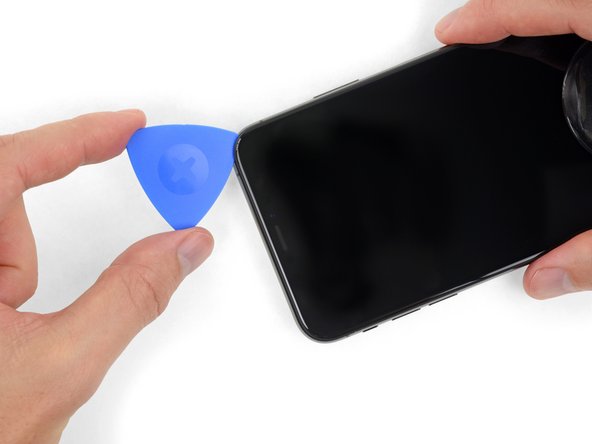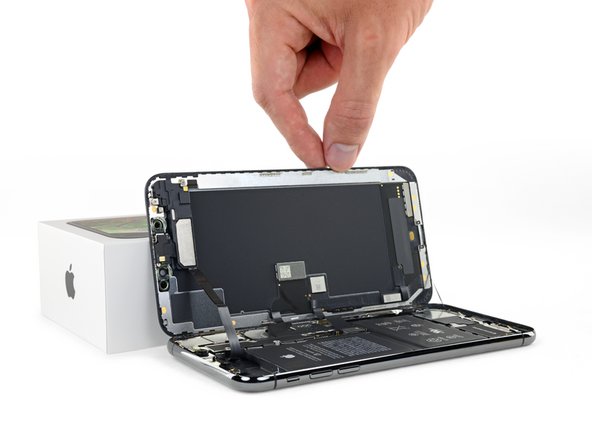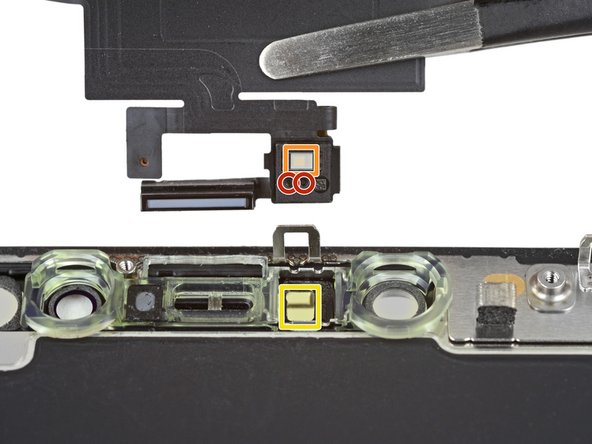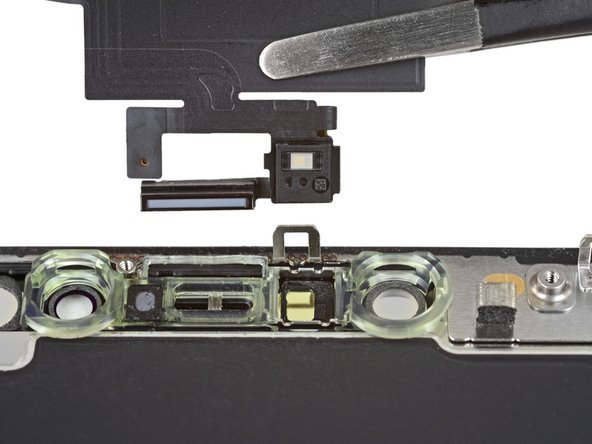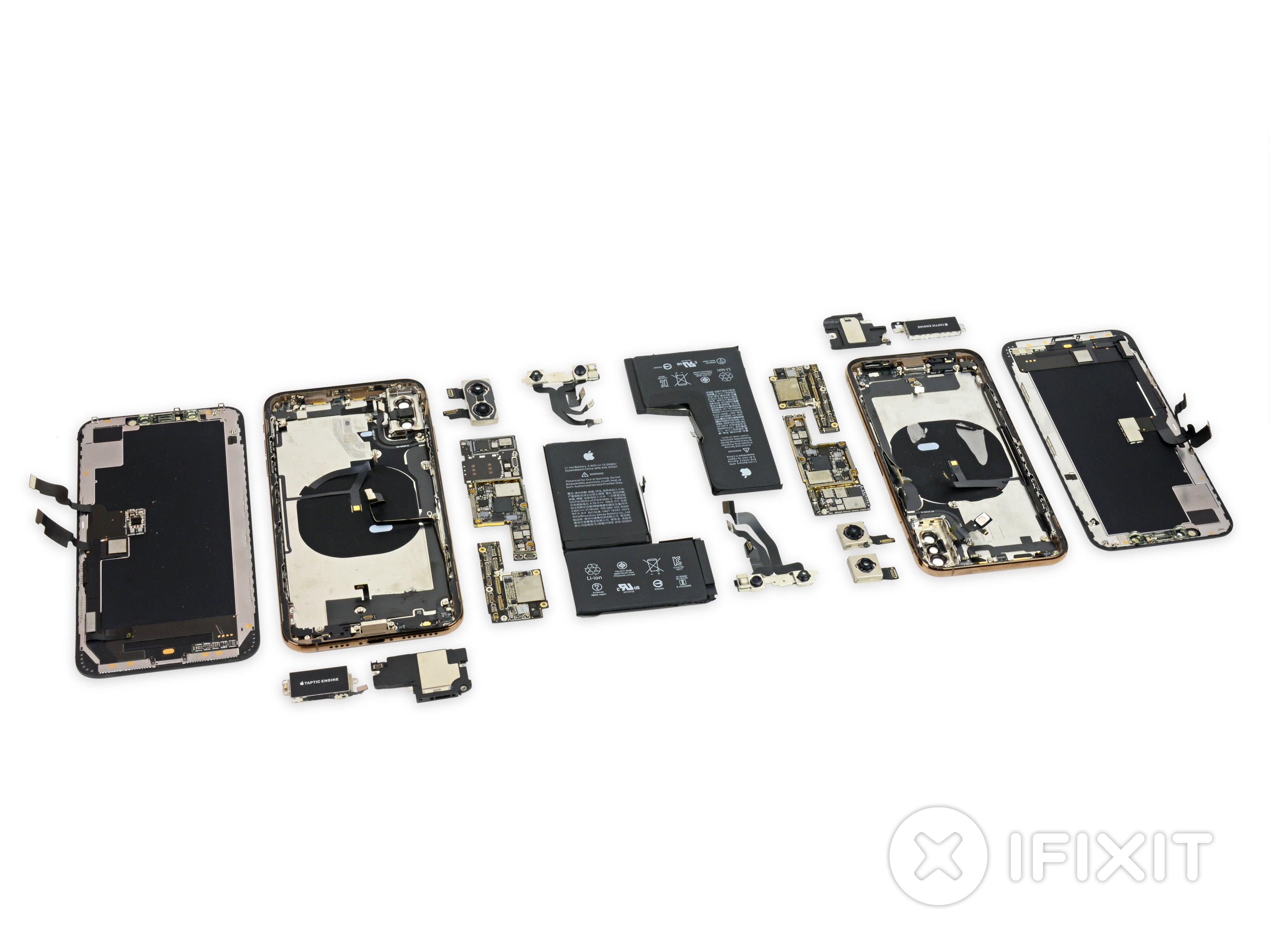iPhone XS Max Screen Replacement
Duration: 45 minutes
Steps: 33 Steps
The earpiece speaker and sensor assembly, securely attached to the back of the display, is custom-matched to your iPhone right from the factory. It’s like a personalized match made in tech heaven!
Got a cracked or unresponsive iPhone XS Max screen, or no picture when you power it on? This guide will help you get your phone back in action with a fresh new display assembly. Heads up: the combined earpiece speaker + sensor assembly attached to the back of the screen is uniquely paired to your iPhone from the factory, so you’ll need to carefully transfer it from your old screen to the new one. This assembly includes the flood illuminator, a key part of Face ID’s biometric security. If it gets damaged or replaced, Face ID won’t work anymore, so handle these parts with extra care. If something does go wrong, only Apple can fix Face ID. Also, note that True Tone will be disabled after replacing the screen, even if you use an original Apple display.
Step 1
Hey there! Before you dive in, make sure your iPhone battery is under 25%. A fully charged lithium-ion battery can be a bit dramatic if it gets punctured, potentially leading to a fiery situation. Safety first, my friend!
- First things first, let's power down your iPhone before we dive into the disassembly fun!
- Next up, grab your trusty screwdriver and remove those two 6.9 mm-long pentalobe screws at the bottom edge of your iPhone. You've got this!
- Just a heads up: when you open your iPhone's display, it might mess with those nifty waterproof seals. Be sure to have some replacement seals handy before moving on, or keep your iPhone away from any liquids if you're reassembling without them. Let's keep that tech safe and sound!
Step 2
Too much enthusiasm with your opening pick can spell trouble for your device—so let’s mark that pick and keep things chill.
Feeling extra precise? Mark different measurements on each corner for ultimate pick control.
Or, slap a coin on your pick about 3 mm from the tip for an instant depth gauge.
- Grab your trusty opening pick and slide it in for a little adventure! First things first, measure about 3 mm from the tip and give it a little love tap with a permanent marker to mark your spot. You're on your way to success!
Step 3
Pop on some safety glasses to keep your eyes safe from any rogue glass bits that might decide to take a little trip during the repair.
Got a cracked iPhone screen? Keep those shards in check and avoid any ouchies by taping over the glass before you start your repair.
If you're having trouble, a little trick is to superglue the suction cup right onto the screen to get a better grip.
- Start by laying down some overlapping strips of clear packing tape across the iPhone's screen, making sure to cover the entire face. It's like giving your phone a cozy blanket!
- If the suction cup isn't playing nice in the upcoming steps, no worries! Just take a sturdy piece of tape (like duct tape) and fold it into a handy handle to lift the screen instead. You've got this!
Step 4
The next three steps show off the Anti-Clamp—a handy gadget we whipped up to make opening your device way smoother. If you're not rolling with the Anti-Clamp, just jump ahead three steps for a different approach.
Want all the details on working the Anti-Clamp? Check out the guide for the full rundown.
If your iPhone is slicker than a greased watermelon and the Anti-Clamp just won’t grip, slap on some tape to give it a little extra traction.
- Pull the blue handle backward to release the Anti-Clamp's arms.
- Slide the arms over either the left or right edge of your iPhone.
- Place the suction cups near the bottom edge of the iPhone—one on the front and one on the back.
- Press the cups together to create a strong suction hold on the area.
Step 5
- Grab the blue handle and pull it forward to lock those arms into place.
- Turn the handle a full 360 degrees, or just keep going until the suction cups start stretching—don't worry, you're on the right track!
- Double check that the suction cups stay in line with each other. If they start to get a little out of sync, just loosen them up a bit and realign the arms.
Step 6
Turn no more than a quarter turn at a time, then take a breather for a minute. Let the Anti-Clamp and a little patience do their magic!
Feel free to get creative with your heat sources! A hair dryer, heat gun, or hot plate can all work wonders. Just remember, too much heat can be a bummer for your display and internal battery, so keep it cool and take your time.
If the Anti-Clamp isn't making enough room for you, don’t sweat it! Just apply a bit more heat and give that handle a quarter turn. You've got this!
- Warm up your trusty iOpener and slide it right through the arms of the Anti-Clamp.
- Bend that iOpener so it rests snugly on the bottom edge of the iPhone.
- Hang tight for a minute to let the adhesive loosen up and create a handy little gap.
- Gently slide an opening pick into that gap beneath the screen and the plastic bezel—just avoid the screen itself!
- Feel free to skip the next three steps.
Tools Used
Step 7
Warming up the lower edge of your iPhone can work wonders by loosening the sticky stuff holding the display in place, making it a breeze to get it open.
- Grab a hairdryer, heat gun, or an iOpener, and give the lower edge of your iPhone some warm love for about a minute. This will help soften up that stubborn adhesive underneath, making things way easier to handle!
Tools Used
Step 8
- If you’re rolling with just one suction handle, stick it right on the bottom edge of the phone—just steer clear of that curved glass part!
Tools Used
Step 9
The adhesive keeping your display sealed tight is no joke; it’s pretty solid stuff. Getting that first gap open might take a little muscle. If you're struggling, don't worry—just apply a bit more heat, and gently wiggle the screen up and down to weaken the adhesive. Once you’ve got a tiny gap, you’ll be all set to slide in your tool and keep going.
- Give the suction cup a steady upward pull—think slow, strong, and smooth. You’re aiming for a tiny gap between the front panel and the back case.
- Slide your opening pick into that gap, aiming for the space between the screen and the plastic bezel. Stay clear of poking the screen directly—your pick wants to be the screen’s neighbor, not its invader.
Step 10
Keep your pick under 3 mm to avoid messing with the delicate internals. A little caution goes a long way!
- Gently slide the opening pick around the bottom left corner and up along the left side of the iPhone, carefully cutting through the adhesive that’s keeping the display stuck in place.
Step 11
Watch out for those fragile cables snuggled along the right edge of your iPhone! It's best to steer clear with your pick here, or you might end up giving them a little too much love and causing some damage.
Step 12
Keep your pick shallow—no deeper than 3 mm—or you might give those display cables a bad day.
- Slide your pick back in at the bottom edge of the iPhone, then glide it up along the right side to keep loosening that stubborn adhesive.
Step 13
Those clips are delicate—go easy on them and take your time.
Keep your pick shallow—don’t go deeper than 3 mm, or you might mess with the front panel sensors.
The top edge of the display is held in place with a mix of glue and clips, keeping everything snug and secure.
- Gently slide the opening pick around the top corner of the display, giving it a little nudge down toward the Lightning port. Keep it cool, take your time.
- Once you’re at the opposite corner, slide the pick over and cut through any remaining adhesive holding the display in place. You got this!
Step 14
- Grab the little tab on the suction cup and give it a gentle tug to pop it off the front panel.
Step 15
Hold on a sec! Don't go fully separating that display just yet, as there are still some delicate ribbon cables holding it tight to the iPhone's logic board. They've got a bit of a bond going on, so let's be gentle here.
- Gently open your iPhone by swinging the screen up from the left side, just like cracking open a hardcover book—but way cooler.
- Find something sturdy to lean the screen against while you work your magic on the inside. No screen faceplants allowed!
- When you’re putting it all back together, set the screen in place, line up the clips along the top, and press the top edge in gently before snapping down the rest. If it’s acting stubborn and not clicking in, double check those clips around the edge to make sure they’re not bent out of shape.
Step 16
As you go through this repair, keep track of every screw and make sure it finds its way back to the right spot. That way, your iPhone stays safe and sound, without any mix-ups!
- First, grab your screwdriver and remove the four Y000 screws that are holding the logic board cover bracket in place. Here’s the breakdown of the screw sizes you’ll be dealing with:
- Two 1.1 mm screws
- One 1.5 mm screw
- One 3.7 mm screw
Step 17
The bracket might be sticking a bit. Give it a gentle lift while applying a steady pull to break it free.
- Take off the bracket.
- Before you seal everything back up, now's a solid time to power on your iPhone and make sure all the functions are working smoothly. Once you’ve confirmed it’s all good, power it down completely before moving on.
Step 18
Be careful not to mess up the black silicone seal around this and other board connectors. These little guys work hard to keep water and dust out, so treat them like the VIPs they are.
- Gently use a spudger or even a clean fingernail to lift the battery connector up and out of its socket on the logic board.
- Once free, give the connector a little bend away from the logic board so it doesn’t accidentally touch the socket and power up the phone while you’re working.
Tools Used
Step 19
- Grab your trusty screwdriver and loosen up the three screws holding down that display connector bracket:
- Two screws that are 1.5 mm in size – easy, right?
- One more screw, this time 1.1 mm, to finish the job.
Step 20
- Lift out the bracket and set it aside like a pro.
Step 21
- Gently pry open the front panel sensor assembly connector with a spudger tip or a nail. It should come apart easily, but don't rush it—just take your time.
Tools Used
Step 22
- Gently use a spudger or even your fingernail to unplug the OLED panel cable connector.
- When reconnecting, line up one side of the connector and press down until you hear a click, then do the same on the other side. Avoid pressing in the middle, since misalignment can bend the pins and cause permanent damage.
Tools Used
Step 23
- Grab a spudger or just your fingernail and carefully lift the digitizer cable connector out of its socket. No rush, just a gentle nudge!
- If your screen starts acting up after the repair and doesn't respond to touch, don't panic! Just disconnect the battery, re-seat that connector, and make sure it clicks back into place. Check for any dust or stuff that could be blocking the socket. It should be good to go!
Tools Used
Step 24
The front panel sensor assembly flex cable is gently stuck in place—think of it like a sticker that doesn’t want to say goodbye. Take your time peeling it up so everything stays happy.
- Gently lift the cable and let the adhesive do its dramatic separation—no force needed, just a little patience!
Step 25
- Take out the display assembly.
- When putting everything back together, take a breather here if you want to swap out the waterproof adhesive sealing the edges of the display.
Step 26
- Take out the three Y000 screws holding down the speaker/sensor assembly:
- One screw, 1.4 mm
- Two screws, 1.5 mm
Step 27
The speaker is attached with a super delicate ribbon cable, so handle it with care! We wouldn't want you to accidentally give it a workout it didn't ask for.
The earpiece speaker is gently stuck in place.
- With your trusty spudger in hand, carefully slide it under the top edge of the speaker assembly. Give it a gentle nudge to flip it over, bringing it down and away from the display's top edge. You've got this!
Tools Used
Step 28
- Grab your trusty hairdryer or heat gun, or whip up an iOpener, and give the top front of your display a warm hug for about 1-2 minutes. This will help loosen up the adhesive that's keeping those sensors snug and secure.
Tools Used
Step 29
- Slide the edge of your opening pick gently under the flex cable right beneath the microphone—think of it as sneaking into a VIP section.
- Give it a little twist to separate the microphone, but go easy so you don’t put any stress on that delicate flex cable.
- If the microphone is clinging on for dear life, grab the pointy end of your spudger and coax it out of its notch in the front panel.
Tools Used
Step 30
Gently lift the speaker and keep it out of the way for easier access. Watch out for that delicate flex cable—no tugging allowed!
- Starting from the left side, slide an opening pick carefully underneath the flex cable and beneath the proximity sensor plus flood illuminator module.
- Gently wiggle and lift the module to free it from its slot in the front panel.
Step 31
The sensor is still connected to the sensor assembly by a super delicate ribbon cable. Treat it like it's made of spun sugar—handle with care to avoid any mishaps or damage!
If the sensor refuses to let go after a few seconds, give it a little extra heat and try again.
- Grab your trusty tweezers and give that ambient light sensor a gentle wiggle to coax it out of its little display nook. You've got this!
Tools Used
Step 32
- If you've successfully removed the entire ambient light sensor as shown in the first photo, you're all set to move on to the next step.
- If the white diffuser strip got loose and is still stuck in the display, like in the second photo, no worries. Just carefully lift it from the top edge with a thin blade or pry tool. You can always heat it up first to make it easier.
- When it's time to put things back together, start by installing the diffuser back into the display. Make sure it's facing the right way (the front-facing side is shown in the first image, and the back side in the third).
- Next, place the ambient light sensor on top of the diffuser. Hold the sensor in place while securing the earpiece/sensor assembly with screws. Once the screws are tightened, the sensor will stay in place and work like a charm.
Step 33
- Line up your new part with the original one—sometimes you’ll need to move a few bits over or peel off some sticky backing before it’s ready to go.
- Put your device back together by reversing the steps above.
- Got some electronic junk left over? Take it to an R2 or e-Stewards certified recycler to keep things green.
- If things didn’t quite work out, swing by our Answers community for some troubleshooting tips, or if it’s really tricky, you can always schedule a repair.

































